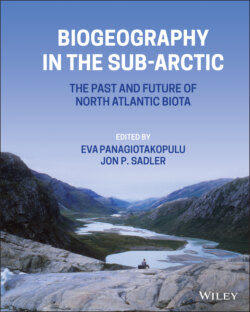Читать книгу Biogeography in the Sub-Arctic - Группа авторов - Страница 18
The Iceland Plume
ОглавлениеThe sudden and massive onset of magmatic activity in what may be broadly termed the north Atlantic region during the early Cenozoic (i.e. in the Palaeocene and Eocene epochs, between 66 and 34 Ma) has been attributed to a dramatic increase in the temperature of the underlying mantle starting at around 62 Ma. The most plausible explanation for this is that it was due to the arrival at shallow levels of an abnormally hot mantle body, namely a mantle plume. However, some sea‐mounts in the Rockall Trough, dated at 70+/−1 Ma, may indicate some precursor plume activity commencing in the Cretaceous (O'Connor et al. 2000).
Figure 2 The pattern of magnetic stripes in the North Atlantic, 2005. Geological Map of the World. Scale: 1 : 50 000 000.
Source: Published by CGMW & UNESCO.
The opening of the North Atlantic (and the subsidiary opening of Baffin Bay west of Greenland) is believed to have involved complex interaction between this plume (the proto‐Iceland plume evolving to the Iceland plume) and ‘normal’ sea‐floor spreading processes (White 1997; White and McKenzie 1989; Fitton and Larsen 2001; Smallwood and White 2002). The abundant generation of magma gave rise to a great igneous province prior to and accompanying the sundering of Laurussia and the creation of the embryonic North Atlantic Ocean. This province embraced a large region including eastern Greenland, a large part of the Norwegian shelf (the Vøring Plateau), the Faeroes and the Hebridean and Northern Irish parts of the British Isles. The cause of this magmatic activity is held to be partial melting generated by the proto‐Iceland plume as is the, approximately contemporaneous, activity that occurred across part of western Greenland and eastern Baffin Island. The magmatism commenced abruptly and was also relatively short‐lived, being mostly confined within 2–3 million years (White 1988). Not only were prodigious quantities of basaltic magma produced but also unusually magnesian (‘picritic’) magmas signifying exceptionally high temperatures were erupted, mainly in the opening stages of the activity. The time interval between the start of continental lithosphere stretching and creation of embryonic ocean was short, perhaps only 4–6 Ma (Smallwood and White 2002). This suggests that injection of great volumes of magma into the continental lithosphere weakened it, facilitating rapid thinning leading to its eventual failure.
Evidence of continental uplift preceding the magmatism is plausibly attributed to the arrival (‘impact’) of the buoyant and abnormally hot mantle plume. Uplift and magmatism preceded the continental rupturing that marked the genesis of a new ocean floor. At its earliest arrival the plume axis is inferred to have lain beneath west‐central Greenland but, as Greenland drifted westwards across the axis of the plume, the latter came to underlie a more central site under Greenland by 55 Ma (Lawver and Müller 1994; Saunders et al. 1997).
After first encountering the continental lithosphere the plume, with a temperature some 150 °C hotter than the normal mantle, spread out rapidly beneath the lithosphere in a crudely circular disposition ~2500 km diameter (White and McKenzie 1995; Smallwood and White 2002). It caused transient crustal uplift, large‐scale volcanism and complementary intrusive activity in conjunction with stretching and thinning of the continental lithosphere. Eventually the continental lithosphere parted, sea‐floor spreading commenced and the North Atlantic Ocean was born.
The Kangerdlugssuaq area of East Greenland is believed to have lain above the plume head at some stage (Brooks 2011). Striking evidence relating to the East Greenland uplift is provided by a horizon of conglomerate a few metres thick (Figure 3a and b, see Plate section). This distinctive conglomerate was noted by Maync (1942) and Koch and Haller (1971) and was referred to as ‘the breakup unconformity’ (Larsen and Saunders 1998). It crops out at intervals along the east Greenland coast from Wollaston Forland (76°N) and the Hold with Hope peninsula (73–74°N: Upton et al. 1980) to the Kangerdlugssuaq region (67°N; Soper et al. 1976) and abruptly overlies fine‐grained marine Cretaceous sediments. It indicates change to a high‐energy sedimentary environment and reflects significant tectonic uplift of the source region, inferentially at no great distance to the west (Upton et al. 1980). Although this unconformity is merely one of a number of Palaeogene unconformities spread in time and place over the North Atlantic region, now regarded as reflecting variations in flux of the Iceland plume, its position immediately beneath the volcanic sequence suggests that its description as ‘the’ break‐up unconformity may not be inept.
Figure 3 (a) Conglomerate from a 2–3 m thick stratum separating Cretaceous shales from the base of the overlying plateau lavas on Wollaston Forland, East Greenland (75° N). Cobbles are of quartzite and muscovite granite. (b) Aerial photograph of the same (white) stratum on Kap Broer Ruys, East Greenland (73°30′N). Well‐stratified dark grey Cretaceous shales beneath and brown/black lavas above.
Source: B.G.J. Upton.
Early in the Eocene mantle temperatures in the head of the plume may have fallen rapidly (Smallwood and White 2002) and the plume is inferred to have assumed a narrower sub‐cylindrical form with a ‘central core’ about a 100 km across. Magmatism due to this ‘plume tail’ marked out the shallow submarine welt of the Greenland–Iceland–Faeroes ridge as the Greenland/American tectonic plate migrated westwards. This ridge is characterized by an abnormal thickness (30–40 km) of oceanic crust and rises to shallow depths. The plume tail itself (the Iceland plume) is now considered to underlie eastern Iceland.
